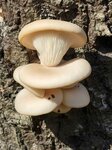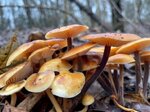


It may be surprising, but there are a few edible wild mushrooms that one can find during wintertime. The good thing is that hunting them gives you something to do while you’re cross-country skiing or walking in the dormant woodlands.
If you find any edible species in the winter, they will have no bugs in them at all. There is no insect hatch occurring in the winter. Many wintertime species are also cultivated and sold commercially. Still, they always taste much better when found in the wild, growing out of the natural substrate, such as decaying trees, stumps, and branches.
Wintertime species are all saprobic, meaning they decay the dead parts of trees. They are not part of the other well-known group of fungi that communicate with and between trees and other flora known as mycorrhizal fungi. Saprobic fungi aren’t killers but merely essential composters of the forest, taking the sugars out of the cellulose and lignin in trees and branches while converting the rest of the wood into essential forest compost. That is also precisely why they can be grown commercially. All you need is sawdust or spawn material and some good spores.
Winter fruiting, the growth of the mushroom itself, typically occurs if there is a break in the cold weather, a warming spell, but can also occur in below-freezing temperatures. Freshly growing mushrooms have firm tissue that can withstand occasional freezing. Lately, our winters have been filled with many weeks of above-freezing temperatures, so you are even more likely to encounter some of the following when walking your dog, jogging, or skiing.
The common Oyster Mushroom, Pleurotus ostreatus, is one of the most likely winter fungi you can find and has a medium to large cap, around 3-8 inches, and always grows on wood, typically elms, maples, or other hardwoods. Their white, grey or brownish caps grow in clusters with their gills running across the underside of their caps and down their stem if they have one. It is worth smelling them in the grocery store because their odor is quite unique and helps you identify them in the field. Their shelf-like growth pattern allows you to lift a cap and see the color of the spore deposits below, which are white to pale lilac. Spore color is a for-sure way to rule out poisonous lookalikes for most mushrooms in general and is very helpful to know. There are no poisonous lookalikes for Oysters; however, some similar fungi might be bitter, and you wouldn’t bother eating them anyway. They include Angel Wings, which are very thin and grow on conifers, the Late Oyster, which has a greenish slimy cap and is bitter if not cooked right, and the Mock Oyster, which is small, fuzzy, quite orange, and bitter.
The Velvet Foot or Enoki, Flammulina velutipes, is a very delicious mushroom, much tastier found in the wild than the cultivated variety called Enoki. They look totally different and are skinny, white, sold in big clusters, and lack flavor. The Velvet Foot has a two-to-three-inch cap and grows in clusters on wood with a long stem. Its cap is often slightly slimy, and its gills are directly attached to its stem and do not run down it, a feature called being "recurrent," nor do they have a notch where the gills connect. Their overlapping caps
reveal white spores, which helps separate them from their one poisonous lookalike, Galerina marginata, which has brown spores and almost always has a brown ring on its stem.
Brick Caps, Hypholoma lateritium, are another delicious winter fungi that also grow directly out of wood and often in “troops”, a term used for mushrooms growing very near each other but not out of the same clustered bases. All of these species are saprobic, meaning they decay wood, and that is why they are found directly attached to it and not growing out of the earth. Brick Caps have brownish to brick-red caps, which are quite distinctive and are also typically paler at their cap margin. Their stems are often reddish near their base, and they have dark purplish spores which can fall in large deposits on neighboring caps, making them look dirty. That’s why I ignored them for years until I realized how tasty they were when sautéed. A good one to learn.
The Amber Jelly Fungus, Exidia recisa, is a very common mushroom found dried in Asian grocery stores and in your soup at most Chinese restaurants. They don’t have much flavor, but they do have good texture and nutritional value. Amber Jellys are very common stick and branch decayers in the forest and are not found growing on trunks of trees. They grow in large clusters and their gelatinous looking dark brown to purplish-brown flesh is semi-translucent. They dry very quickly for preservation purposes and are easy to reconstitute when you add them to soups or stir frys.
So, the overall rules for winter hunting are to hunt in woodlands. Hardwood stands are best. Pay particular attention if it has been warm for quite some time or if you are in the middle of a warming spell and try to go out and look for fungi in general at least a few times per week. You will almost certainly encounter some of these fun edible fungi in your travels. As always, never eat a wild mushroom unless you’ve been shown it by an expert and, ideally you have learned the features of its look-alikes as well as those of the mushroom itself. Happy hunting!